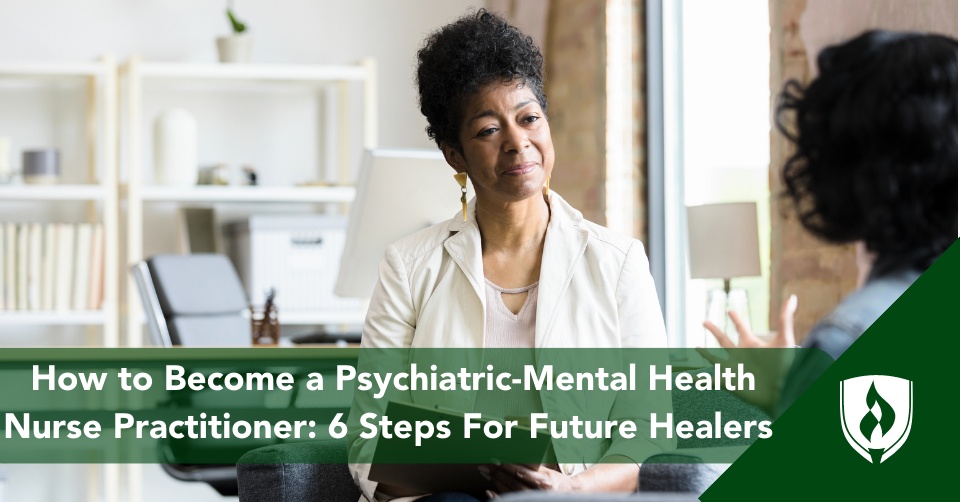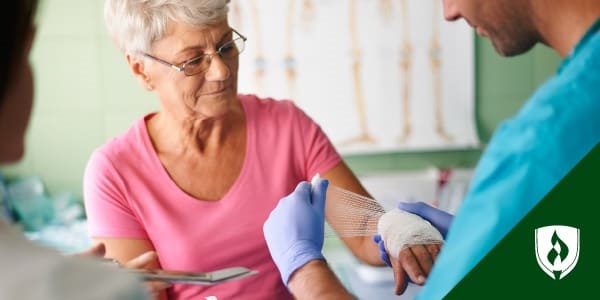How to Become a Psychiatric-Mental Health Nurse Practitioner: 6 Steps For Future Healers
By Brianna Flavin on 07/05/2023

We tend to think of nurses dealing with physical ailments. They bandage wounds, hook up IVs and set broken bones. But health is about so much more than bones and blood. And nurses tend to jump in anywhere health needs arise.
Mental health is no exception.
If you've had any experience with mental illness, than you know mental health issues can be just as debilitating to a patient's overall quality of life as physical ailments. They can also cause physical ailments—blurring the lines we perceive between body and brain.
According to the National Alliance on Mental Illness, 22.8% of U.S. adults (57.8 million people) experienced mental illness in 2021.1 While many people in that group may not be able or willing to find treatment, that should still show you how badly we need mental health professionals around the country.
Psychiatric-mental health nurse practitioners (PMHNPs) are one group that can help answer that call. This type of advanced practice nurse specializes in mental health. A great PMHNP saves lives and improves patient outcomes, using both clinical skills and therapeutic techniques to help their patients find balance.
Sound interesting? Find out how to become a psychiatric-mental health nurse practitioner and consider what you could do in this powerful nursing role.
What are psychiatric mental health nurse practitioners, and what do they do?
Psychiatric-mental health nurse practitioners, sometimes called psychiatric nurse practitioners, are a type of advanced practice registered nurse (APRN) who care for patients with mental illnesses and psychiatric disorders. They diagnose and treat psychiatric disorders or substance abuse problems. This includes conducting patient assessments, guiding therapy sessions and prescribing medication when appropriate.
Patients can rely on these mental health nurse experts to help them manage mental health disorders and navigate psychiatric and physical symptoms. Psychiatric nurse practitioners are considered primary care providers and don't need another medical professional to oversee their work.
Some psychiatric mental health nurse practitioners might work in care teams with therapists, psychiatrists and other healthcare professionals, collaborating for their patients' overall mental health care.
Take a moment to consider how many different kinds of mental health needs people might have. Everything from anorexia to PTSD, from generalized anxiety disorder to addiction.
When you add medication options, other medical conditions, traumatic experiences and more—you’ll see how far the scope of psychiatric mental health care stretches.
Let's take a closer look at the steps aspiring PMHNPs need to take.
To delve deeper into this crucial aspect of mental healthcare, explore What Does a Psychiatric-Mental Health Nurse Practitioner Do?
How to become a psychiatric-mental health nurse practitioner
The requirements for becoming a PMHNP are substantial and can be a little complicated if you're unfamiliar. Let's break it down step-by-step.
1. Become a registered nurse
If you want to get to the role of psychiatric-mental health nurse practitioner, you'll first need to become a registered nurse (RN). That means getting into nursing school and completing an associate's degree in nursing (ADN) or bachelor of science in nursing (BSN) program.
After graduation, you'll need to meet all other licensure requirements in your state, including passing the NCLEX-RN® examination. This is a crucial standardized test to evaluate your overall competence and ability to practice safely as a registered nurse.
There are a few different educational paths to becoming an RN, but if your ultimate goal is to become a PMHNP, you'll want to complete a bachelor's degree program. Most nurse practitioner graduate degree programs (MSN-NP) require applicants to hold a bachelor's degree and an active nursing license.
2. Build nursing experience
While this step isn't a requirement for most psychiatric-mental health nurse practitioner programs, working as an RN for a while can give you critical experience to draw from. Psychiatric care has so many physical components.
If you can, focus your time as an RN in environments that relate to mental health. Nursing roles in community mental health centers or mental health facilities could be a perfect choice. Ask other nurses about their experience with mental health wherever you work, since mental health does touch everything in one way or another.
Try to get experience in both inpatient and outpatient environments, and practicing different care models. Try asking to shadow colleagues who provide counseling, psychotherapy and supportive interventions, as well as established PMHNPs who work within the advanced practice scope.
This will help you get a better feel for what working in the mental health field may entail and can help you determine if attending a psychiatric-mental health nurse practitioner program is the right move for you.
Many RNs will pursue certifications, including the generalist Psychiatric-Mental Health Nursing Certification (RN/PMH-BC) offered by the American Nurses Credentialing Center (ANCC)®.
This certification can make your application more competitive to work as an RN in mental health environments. It can also be a note in your favor when you apply for a PMHNP program.
3. Identify and apply to a psychiatric-mental health nurse practitioner program
No matter the path you choose after earning RN licensure, you'll need to eventually complete a graduate degree program to become a PMHNP. This is another substantial step worth careful consideration. Prospective PMHNPs will want to consider several factors, including:
- Program cost
- Admissions requirements
- Time commitment and schedule
- Clinical practicum opportunities
- Location
- Faculty
Finding the right fit may take a little time, so do your research into PMHNP program options. During this stage, you should start to develop a clearer picture of the time commitment and what's expected of you to succeed.
4. Complete your coursework
Once you've settled into a PMHNP program, it's time to dive into your coursework. At Rasmussen University, PMHNP students work through a rigorous slate of courses designed to develop their advanced practice nursing skills. This includes courses like:
- Foundations of PMHNP Practice
- Psychopathology and Neurobiology of Mental Health Disorders
- Psychopharmacology
- Psychiatric Mental Health Treatment Modalities
Additionally, PMHNP students need to complete 630 clinical hours in practicum experiences focused on the following areas:
- Pediatrics and family
- Adults
- Aging adults
- A specialty focus area of your choosing with an experienced preceptor
These practicum experiences can provide unexpected career clarity. You might have a picture of a specific role in your head that reality doesn't really match. And you might fall totally in love with one of the practice areas you hadn't considered before.
These experiences are also key to highlight the difference between mental health nursing in theory vs. what it actually looks like in the world. You get a much better view of the problems and gaps in the healthcare system, and you get the chance to see how your knowledge applies directly to real people's lives.
5. Seek board certification and licensure
With coursework completed, the next essential step will be to obtain the Psychiatric Mental Health Nurse Practitioner-Board Certified (PMHNP-BC) credential through the ANCC. This requires passing a 175 question exam covering the following topic areas:
- Scientific foundation
- Advanced practice skills
- Diagnosis and treatment
- Psychotherapy and related theories
- Ethical and legal principles
After your certification, you'll also need to apply for state licensure and meet all other requirements, like a criminal background check.
6. Search for your first position!
Last, but certainly not least, is to find employment as a PMHNP. You'll have some options at this stage, whether that's working at a psychiatric hospital, an assisted living facility, a mental health center or an independently-owned practice.
At this step, you've ideally made connections—and positive impressions—on potential employers during your practicum experience. Those relationships are often an excellent starting point when beginning a job search.
Additionally, professional organizations like the American Association of Nurse Practitioners, the American Counseling Association, and the American Mental Health Counselors Association have job boards to help you find the right fit.
Do you see the mental health needs around you?
If you're starting from square one, there’s definitely some road ahead of you on the way to becoming psychiatric-mental health nurse practitioner. But if you are interested in mental health nursing, there's no question that society needs you!
As reported mental health disorders are climbing worldwide, patients are looking for psychiatric mental health nurse practitioners they can rely on.
Maybe you already love to promote mental health and the mind-body connection. Maybe you've been through your own trials or mental health disorders and a PMHNP helped you heal and process. Maybe when you look around, you see the need for this vital nursing practice in our world.
Let's build on that. At Rasmussen University, you can find Nursing programs to fit you, whether you're starting from scratch or already working as a nurse on the frontlines.
Check out our Masters of Science, Nurse Practitioner program (MSN-NP) page to learn more about the Psychiatric Mental Health Nurse Practitioner specialization and get a better picture of what this degree looks like and where it could take you!
EDITOR’S NOTE: This article was originally published in December 2021. It has since been updated to include information relevant to 2023.
The MSN Nurse Practitioner program is currently NOT eligible for participation in Title IV federal aid programs.
1Mental Health By the Numbers, National Alliance on Mental Illness. March 2021. [accessed June, 2023] https://www.nami.org/mhstats
NCLEX-RN is a registered trademark of the National Council of State Boards of Nursing, Inc.
American Nurses Credentialing Center is a registered trademark of the American Nurses.




